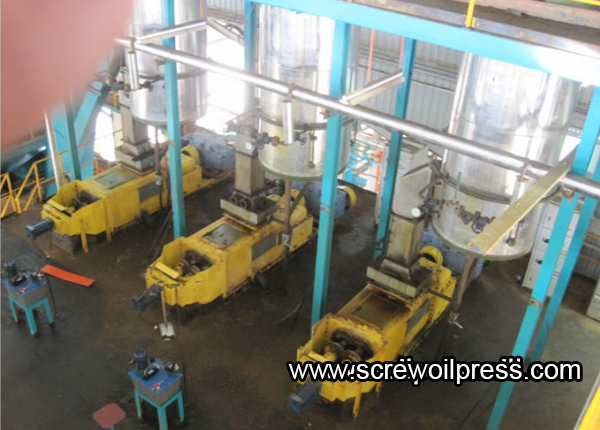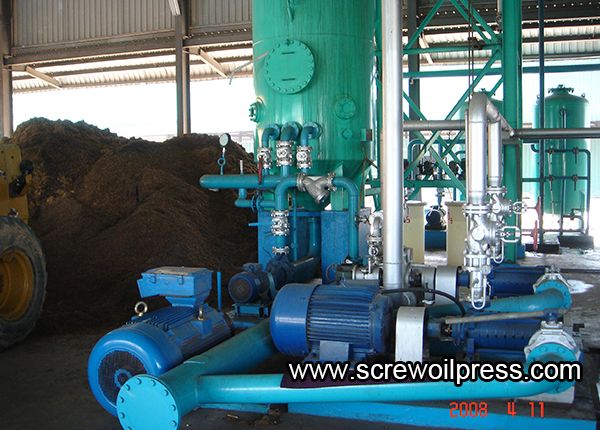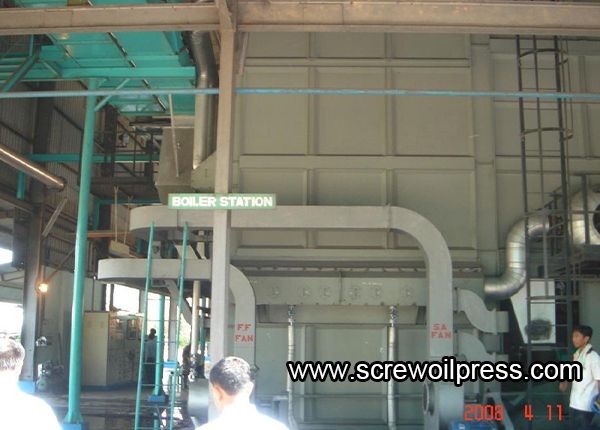- Oil Mill Machinery
- Oil Refinery Machinery
- Oil Processing Plant
- Solvent Extraction Plant
- Animal Oil Processing Machine
- Feed Processing Machine
- Palm Oil Mill
- Industrial Drying Machine
- Grain Processing Machinery

Palm Oil Mill

FFB Fresh Fruit Palm Oil Pressing Plant CPO Extraction Plant
Offer turnkey palm oil press plant solutions from plant layout design, machinery manufacturing, onsite debugging and installing Our palm fruit oil processing plant capacity range from 3t h to 100t h with automatic palm oil mill control system
SEND INQUIRY
Description
Palm Oil Press Production Line Solution with Turnkey Service

The production process of palm oil can be divided into four aspects: crude oil pressing, crude oil refining, palm kernel oil pressing and waste treatment.
Raw Material:Fresh palm fruit with bunch FFB(within 24 hours after picking)
Palm Oil Mill Capacity:5-100t/h FFB
Final products: Crude Palm Oil (CPO) and Palm Nuts/Kernels
Production index: oil loss is less than or equal to 2%, moisture is less than 0.2%, free fatty acid FFA is less than or equal to 5.5%
Energy-efficient, modular assembly, easy to transport and move production
The palm oil is contained in palm pulp, the pulp is high moisture content and rich lipase. Usually we adopt the method of press to produce it, and this technology is very mature.
Before press , Fresh fruit bunch will be taken sterilizer and thresher pre-treatment: After weighting the FFB , it is loaded the FFB conveyor by loading ramp, then the FFB will convey to the vertical sterilizer.
FFB will be sterilized treatment in sterilizer, the FFB will be heated and sterilized treatment for several time to avoid the lipase be hydrolyzed , after sterilizer ,the FFB is distributed bunch conveyor by the mechanical bunch feeder and enter the thresher machine which separate the palm fruit and bunch , for the empty bunch ,it is conveyed empty bunch loading platform and transport it to outside the factory area at fixed period , the empty bunch could be used as fertilizer and repeat use ;
The palm fruit which has passed sterilizer and thresher processing should be sent to digester and then go to special screw press to get the crude palm oil (CPO) form the pulp .
But the pressed palm oil contain a lot of water and impurity which need to be clarified by sand trap tank and treated by the vibrating screen, afterward the CPO will be sent to clarification station treatment section .
For the wet fiber cake which be produced by screw press, after separating nut, it will be sent to boiler house to burnt.

Complete Palm Oil Press Production Line Factory includes:
1. Palm oil mill process of Fresh fruit palm bunch reception
Including palm fruit unloading, cleaning, storage platform during Palm oil milll processing, all hydraulic segmented discharge.

2. Palm oil mill process of sterilization:
the use of high temperature to cook soft fruit bunches and sterilization, easy to separate fruit bunches, soft fruit, increasing the humidity of the fruit, it is easy to take the oil but also to make verification easier separation of the core-shell, preventing enzymatic decomposition, to avoid elevated levels of free fatty acids.
Palm fresh fruit bunches are transported to the sterilization tank using a scraper conveyor and a fruit cage to perform high temperature sterilization .(145 ℃ ,90-120 minutes) .so as to effectively control the free fatty acid content in the raw materials, and provide basic conditions for subsequent processing.

3. Palm oil mill process of threshing:
strong vibrations through the fruit from fruit bunches separated. Fresh palm fruit bunches are sterilized and transported to the thresher drum, which can separate the fruit particles from the bunches by rotating and beating.The fruit is conveyed to digester by screw conveyor.

Mashing. Mixing tank will mash and crush palm fruit until broken after fruit threshing.
4. Palm oil mill process of pressing:
There is also the steam heater in masher. The purpose of mashing is to separate the pulp and nut and crush the palm pulp. At the same time, the steam is used to cook the palm fruit and broke the cell of pulp. Because of cooking, sterilizing, threshing and mashing made the pulp soft and damage pulp cell structure, the palm pulp becomes soft and cell is broken. Then it is sent to continuous screw press.
After pressing, oil palm fruit is divided into two parts: the mixture of oil, water and solid impurities, and the press cake (fiber and nut).
The pulp stone separation obtained CPO and stone, press machine adopts the double screw helix continuous discharge and hydraulic, greatly improving production efficiency.
Capacity from 5t (FFB) / h, 10t (FFB) / h, 15t (FFB) / h, 20t (FFB) / h, 45t(FFB)/h,60t(FFB)/h.

5. Fiber separation. The extrued fiber pie enters air separation system after crushed to get separation of fibers and cores.
6. Separation. Crusher divided fruit core into palm kernel and shell after separated with fiber. Air separation and washing systems separate palm kernels and shells. Shells enters boiler system as fuel, and palm kernels are storage after drying.
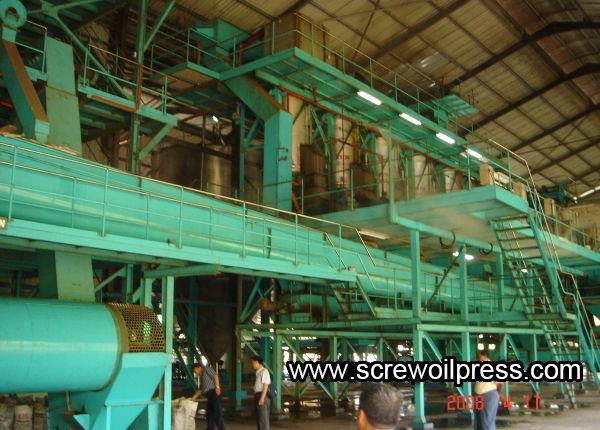
7. Palm oil mill process of clarification:
Machine-pressed crude oil first diluted with water washing, through settlement and filtration, the fiber material removed from the oil, and then carry out continuous settlement, the whole divided into two parts: oil and sediment. The oil and the sludge taken out separated (by 90% pure oil) is taken out of the oil containing 45%-55% of the water, sludge and other things.
Palm oil mill process of purification: oil purification process to improve palm oil purity.
Palm oil mill process of drying: continuous Vacuum drier with the oil out of the water, the water can be reduced to 0.1%.

8. Palm oil mill process of depericarper (splitter): through floating dry processing the fruit core and fibers separated. Fiber and other lighter stuff are blown appearance.
9. Palm oil mill process of crushing (crusher): stone cracked open grain separation kernel and shell. In hydrocyclone, the use of kernel and core-shell particle proportion to their separation.

10.Palm oil mill process of power house: the use of diesel powered generators and turbine generators, more environmentally friendly energy production and electricity consumption to power.

11.Palm oil mill process of steam boiler: has a strong output, high thermal efficiency, stable and reliable operation, overload capacity, fuel, wide applicability, environmental protection and many other advantages. Water treatment: after setting, filtration, dosing and other processes to ensure that the water quality, but also to ensure oil quality.
12. Crude Palm Oil Storage Tank
The pure crude oil after purification is transported to the crude oil storage tank through pump and pipeline. The crude oil storage tank needs to heat the crude oil regularly to ensure the fluidity of the crude oil. According to the production needs, the pure palm crude oil is pumped to the tanker or tanker at the wharf.
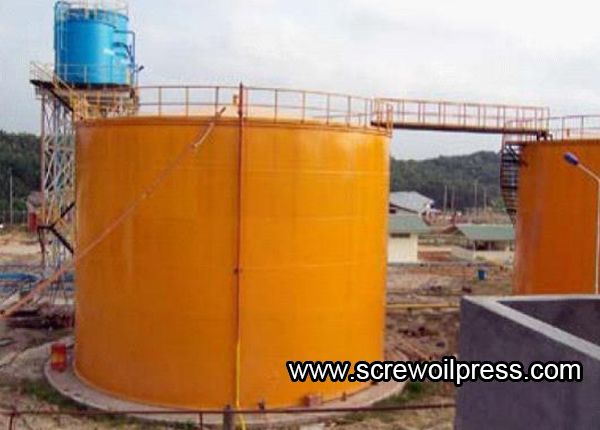
Effluent Treatment System and Water Treatment Plant
This palm oil mill effluent treatment system is cost-effective, only needs adequate space, less investment costs.
Water consumption of the palm oil factory include: furnace feeding water, generator cooling water, production and living water, Only the after treated supply water can meet the sanitary requirement.
Especially, the furnace supply water should be softened first, After anion and cation exchange resin treatment, meet the requirements of the boiler water, then be treated by deaerator for removing oxygen. At last, pump it into temporary tank for storage.

The production process of palm oil can be divided into four aspects: crude oil pressing, crude oil refining, palm kernel oil pressing and waste treatment.
Raw Material:Fresh palm fruit with bunch FFB(within 24 hours after picking)
Palm Oil Mill Capacity:5-100t/h FFB
Final products: Crude Palm Oil (CPO) and Palm Nuts/Kernels
Production index: oil loss is less than or equal to 2%, moisture is less than 0.2%, free fatty acid FFA is less than or equal to 5.5%
Energy-efficient, modular assembly, easy to transport and move production
The palm oil is contained in palm pulp, the pulp is high moisture content and rich lipase. Usually we adopt the method of press to produce it, and this technology is very mature.
Before press , Fresh fruit bunch will be taken sterilizer and thresher pre-treatment: After weighting the FFB , it is loaded the FFB conveyor by loading ramp, then the FFB will convey to the vertical sterilizer.
FFB will be sterilized treatment in sterilizer, the FFB will be heated and sterilized treatment for several time to avoid the lipase be hydrolyzed , after sterilizer ,the FFB is distributed bunch conveyor by the mechanical bunch feeder and enter the thresher machine which separate the palm fruit and bunch , for the empty bunch ,it is conveyed empty bunch loading platform and transport it to outside the factory area at fixed period , the empty bunch could be used as fertilizer and repeat use ;
The palm fruit which has passed sterilizer and thresher processing should be sent to digester and then go to special screw press to get the crude palm oil (CPO) form the pulp .
But the pressed palm oil contain a lot of water and impurity which need to be clarified by sand trap tank and treated by the vibrating screen, afterward the CPO will be sent to clarification station treatment section .
For the wet fiber cake which be produced by screw press, after separating nut, it will be sent to boiler house to burnt.

Complete Palm Oil Press Production Line Factory includes:
1. Palm oil mill process of Fresh fruit palm bunch reception
Including palm fruit unloading, cleaning, storage platform during Palm oil milll processing, all hydraulic segmented discharge.

2. Palm oil mill process of sterilization:
the use of high temperature to cook soft fruit bunches and sterilization, easy to separate fruit bunches, soft fruit, increasing the humidity of the fruit, it is easy to take the oil but also to make verification easier separation of the core-shell, preventing enzymatic decomposition, to avoid elevated levels of free fatty acids.
Palm fresh fruit bunches are transported to the sterilization tank using a scraper conveyor and a fruit cage to perform high temperature sterilization .(145 ℃ ,90-120 minutes) .so as to effectively control the free fatty acid content in the raw materials, and provide basic conditions for subsequent processing.

3. Palm oil mill process of threshing:
strong vibrations through the fruit from fruit bunches separated. Fresh palm fruit bunches are sterilized and transported to the thresher drum, which can separate the fruit particles from the bunches by rotating and beating.The fruit is conveyed to digester by screw conveyor.

Mashing. Mixing tank will mash and crush palm fruit until broken after fruit threshing.
4. Palm oil mill process of pressing:
There is also the steam heater in masher. The purpose of mashing is to separate the pulp and nut and crush the palm pulp. At the same time, the steam is used to cook the palm fruit and broke the cell of pulp. Because of cooking, sterilizing, threshing and mashing made the pulp soft and damage pulp cell structure, the palm pulp becomes soft and cell is broken. Then it is sent to continuous screw press.
After pressing, oil palm fruit is divided into two parts: the mixture of oil, water and solid impurities, and the press cake (fiber and nut).
The pulp stone separation obtained CPO and stone, press machine adopts the double screw helix continuous discharge and hydraulic, greatly improving production efficiency.
Capacity from 5t (FFB) / h, 10t (FFB) / h, 15t (FFB) / h, 20t (FFB) / h, 45t(FFB)/h,60t(FFB)/h.

5. Fiber separation. The extrued fiber pie enters air separation system after crushed to get separation of fibers and cores.
6. Separation. Crusher divided fruit core into palm kernel and shell after separated with fiber. Air separation and washing systems separate palm kernels and shells. Shells enters boiler system as fuel, and palm kernels are storage after drying.

7. Palm oil mill process of clarification:
Machine-pressed crude oil first diluted with water washing, through settlement and filtration, the fiber material removed from the oil, and then carry out continuous settlement, the whole divided into two parts: oil and sediment. The oil and the sludge taken out separated (by 90% pure oil) is taken out of the oil containing 45%-55% of the water, sludge and other things.
Palm oil mill process of purification: oil purification process to improve palm oil purity.
Palm oil mill process of drying: continuous Vacuum drier with the oil out of the water, the water can be reduced to 0.1%.

8. Palm oil mill process of depericarper (splitter): through floating dry processing the fruit core and fibers separated. Fiber and other lighter stuff are blown appearance.
9. Palm oil mill process of crushing (crusher): stone cracked open grain separation kernel and shell. In hydrocyclone, the use of kernel and core-shell particle proportion to their separation.

10.Palm oil mill process of power house: the use of diesel powered generators and turbine generators, more environmentally friendly energy production and electricity consumption to power.

11.Palm oil mill process of steam boiler: has a strong output, high thermal efficiency, stable and reliable operation, overload capacity, fuel, wide applicability, environmental protection and many other advantages. Water treatment: after setting, filtration, dosing and other processes to ensure that the water quality, but also to ensure oil quality.
12. Crude Palm Oil Storage Tank
The pure crude oil after purification is transported to the crude oil storage tank through pump and pipeline. The crude oil storage tank needs to heat the crude oil regularly to ensure the fluidity of the crude oil. According to the production needs, the pure palm crude oil is pumped to the tanker or tanker at the wharf.

Effluent Treatment System and Water Treatment Plant
This palm oil mill effluent treatment system is cost-effective, only needs adequate space, less investment costs.
Water consumption of the palm oil factory include: furnace feeding water, generator cooling water, production and living water, Only the after treated supply water can meet the sanitary requirement.
Especially, the furnace supply water should be softened first, After anion and cation exchange resin treatment, meet the requirements of the boiler water, then be treated by deaerator for removing oxygen. At last, pump it into temporary tank for storage.
Leave a message: Please fill in your information and we will contact you soon.






